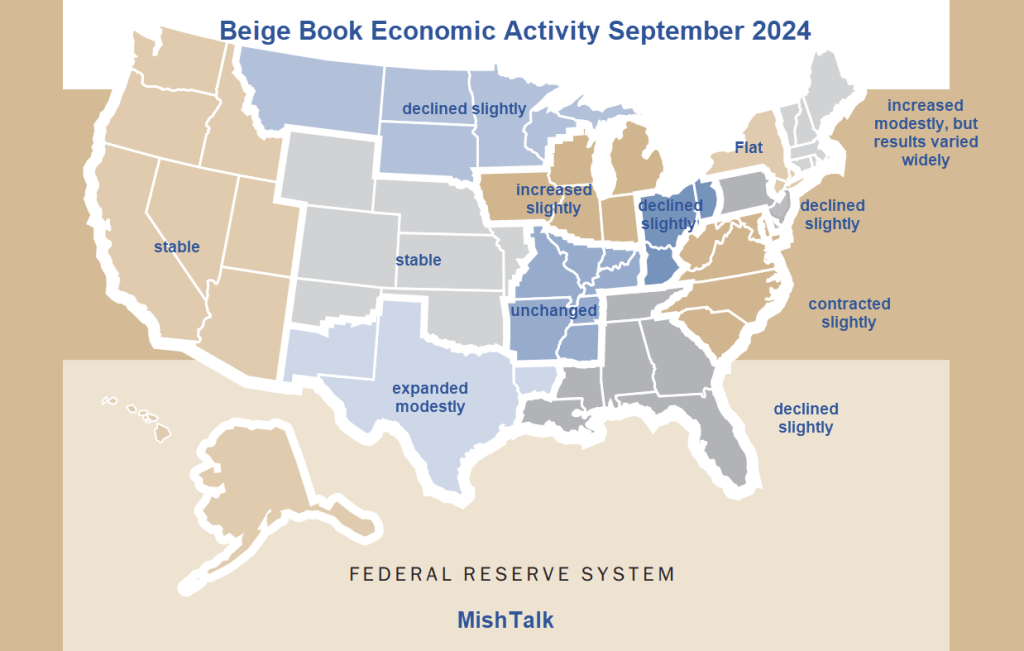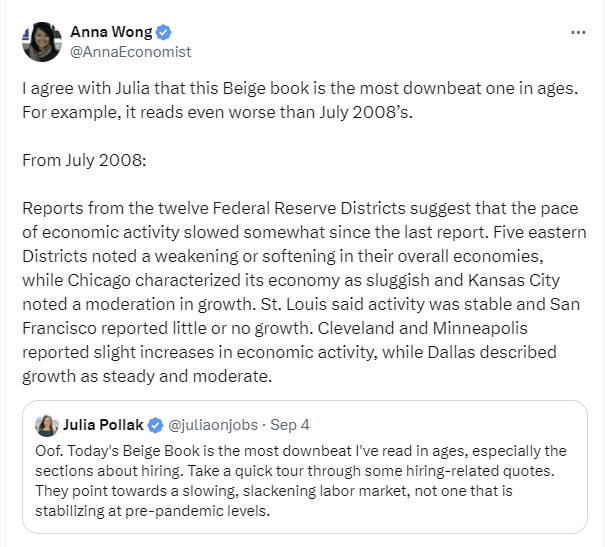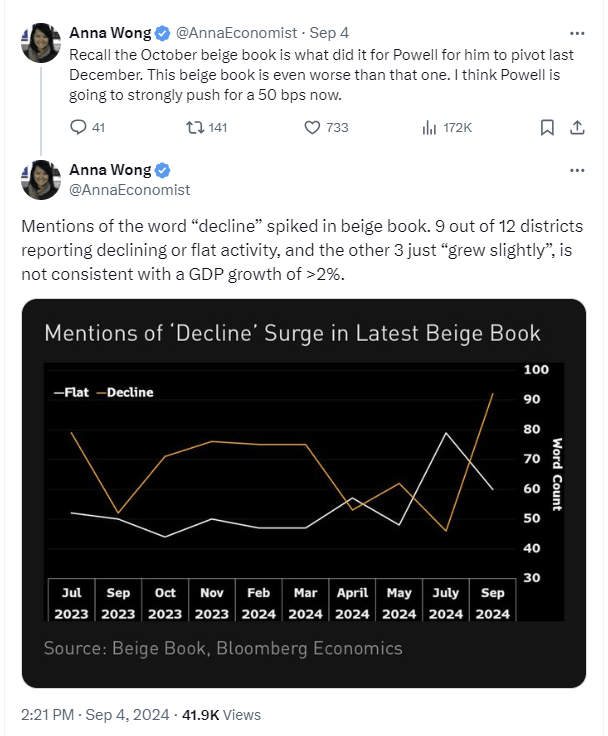Let’s compare current Beige Book conditions to those at the beginning of the Great Recession.

Beige Book January 2008
Let’s take a look at the Fed’s Beige Book Summary of Economic Conditions in the 12 Fed districts in January of 2008. The Great Recession had begun.
Reports from the twelve Federal Reserve Districts suggest that economic activity increased modestly during the survey period of mid-November through December, but at a slower pace compared with the previous survey period. Among Districts, seven reported a slight increase in activity, two reported mixed conditions, and activity in three Districts was described as slowing.
Beige Book March 2008
Next consider Fed’s Beige Book Summary of Economic Conditions in the 12 Fed districts in March of 2008. The Great Recession was underway.
Reports from the twelve Federal Reserve Districts suggest that economic growth has slowed since the beginning of the year. Two-thirds of the Districts cited softening or weakening in the pace of business activity, while the others referred to subdued, slow, or modest growth. Retail activity in most Districts was reported to be weak or softening, although tourism generally continued to expand. Services industries in many Districts, including staffing services in Boston, port activity in New York, and truck freight volume in Cleveland, appeared to be slowing, but activity in services provided some positive news in Richmond and Dallas. Manufacturing was said to be sluggish or to have slowed in about half the Districts, while several others indicated manufacturing results were mixed or trends were steady.
Beige Book July 2008
Next consider Fed’s Beige Book Summary of Economic Conditions in the 12 Fed districts in July of 2008. The Great Recession was in the seventh month.
Reports from the twelve Federal Reserve Districts suggest that the pace of economic activity slowed somewhat since the last report. Five eastern Districts noted a weakening or softening in their overall economies, while Chicago characterized its economy as sluggish and Kansas City noted a moderation in growth. St. Louis said activity was stable and San Francisco reported little or no growth. Cleveland and Minneapolis reported slight increases in economic activity, while Dallas described growth as steady and moderate.
Beige Book Most Downbeat in Ages

September 2024 Fed Beige Book Shows Flat or Declining Economy in 9 of 12 Fed Districts
On September 5, 2024, I noted Fed Beige Book Shows Flat or Declining Economy in 9 of 12 Fed Districts
Overall Activity
- Economic activity grew slightly in three Districts, while the number of Districts that reported flat or declining activity rose from five in the prior period to nine in the current period.
- Employment levels were steady overall, though there were isolated reports that firms filled only necessary positions, reduced hours and shifts, or lowered overall employment levels through attrition. Still, reports of layoffs remained rare.
- On balance, wage growth was modest, while increases in nonlabor input costs and selling prices ranged from slight to moderate.
- Consumer spending ticked down in most Districts, having generally held steady during the prior reporting period.
By District
- Increased Modestly: Boston and Dallas
- Increased Slightly: Chicago
- Flat, Unchanged, Stable: New York, Kansas City, San Francisco, St. Louis
- Decline Slightly: Philadelphia, Atlanta, Minneapolis, Cleveland, Richmond
Strongly Push for 50 Basis Points

That is how I see it too. But the market disagrees. We will have a better idea on Wednesday.
September 2024 vs July 2008
- Increasing Sep 2024: (3) Boston, Dallas, and Chicago
- Increasing July 2008: (4) Kansas City, Cleveland, Minneapolis, and Dallas
- Flat Stable Sep 2024: (4) New York, Kansas City, San Francisco, St. Louis
- Flat Stable July 2008: (3) Chicago, San Francisco, St. Louis
- Decline Slightly Sep 2024: (5) Philadelphia, Atlanta, Minneapolis, Cleveland, Richmond
- Weakening July 2008: (5) New York, Philadelphia, Atlanta, Richmond, Boston
Small Businesses Reducing Workers for the Last Four Months
On Thursday, I noted Small Businesses Reducing Workers for the Last Four Months
ADP data shows small businesses with 1-49 workers have been reducing workers for four months. Those with 20-49 workers have shed workers for 7 straight months.
Hmmm. That must be nothing .
On September 3, I noted Construction Spending Growth Slows in May, Stops in June, Negative in July
Again, that’s nothing.
BLS Negative Job Revisions 15 of Last 21 Months
Also note BLS Negative Job Revisions 15 of Last 21 Months
And the current economic headline conditions are worse than the conditions heading into the 7th month of the Great Recession.
Well, I’m sure that’s nothing too.
